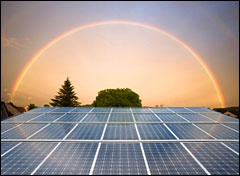New vehicle emissions standards: Good call, Obama.Photo: The White HouseCross-posted from Climate Progress. This is a revision of an earlier article to reflect the evolving international climate negotiations. This post was coauthored by Andrew Light and Jackie Weidman.
The 17th Conference of the Parties (COP17) to the United Nations Framework Convention on Climate Change (UNFCCC) begins today in Durban, South Africa.
In advance of the meeting, some nations have legitimately criticized the United States for its lack of leadership in the development of a climate agreement that puts the world on the path to reducing the carbon and other pollution responsible for climate change.
A variety of issues will confront the Obama administration at the meeting, particularly additional progress on the essential measures advanced last year at COP16 in Cancun, Mexico. Most importantly, COP17 must agree to an implementing document for the Green Climate Fund that will finance adaptation efforts in developing nations likely to be affected by climate change.
Another key element is the emerging deal over how and whether the Kyoto Protocol will be extended for a second commitment period beyond 2012. While the U.S. is not a party to that agreement, the European Union is pressuring all parties at this year’s COP to agree to opening discussions for a new binding treaty after 2020 in exchange for their commitment to keep the protocol in place for another five years.
As they have in years past, the United States negotiating team has been playing hard ball. For example, it demands that any emerging climate agreement after 2020 be relatively symmetrical for all major carbon polluters, especially China. But, as in years past, American efforts to shape the outcome of the meeting are again hampered by criticisms by other nations for its lack of leadership in reducing its own emissions. Connie Hedegaard, European commissioner for climate action, urged that in deciding climate policy, “it only makes sense if major emitters are willing to say, if not what, [then] when are you willing to say you’re willing to commit.”
This year, these critics of the U.S. position should acknowledge that the Obama administration is using its administrative authority to require pollution reductions, despite fervent opposition from nearly all Republicans and some Democrats in Congress. In the last few months, the Environmental Protection Agency scrapped new regulations on smog-forming emissions and delayed rules on greenhouse gas emissions from power plants, setting off criticism from environmental groups that want to see more action on these issues. However, there are other rules in the works that could have a significant impact on global warming pollution. On November 16 and 17, the administration announced two steps that could reduce carbon dioxide pollution from the two largest United States’ sources – motor vehicles and power plants.
The Energy Information Administration reports that coal plants make up 35% of U.S. carbon dioxide emissions from fossil fuels. Likewise, the transportation sector is responsible for 34% of all carbon dioxide emissions by sector. The final versions of rules proposed to reduce pollution from these sources must reflect reductions possible with the most modern technology, and the power plant rules must cover both new and existing sources. If this occurs, the United States would put a major down payment on climate change pollution reductions.
The Obama administration’s new proposed rules to reduce carbon dioxide pollution from cars built from 2017-2025 should be applauded. The November 16 announcement from the Obama Administration represents the most significant step that the federal government has taken to curb greenhouse gas emissions. The joint proposal, from the Environmental Protection Agency (EPA) and the U.S. Department of Transportation (DOT) sets stronger fuel economy and carbon dioxide tailpipe standards for passenger cars and light trucks, designating an average fuel economy of 54.5 mpg in 2025.
This proposal builds on the successful standards that the EPA and DOT are currently implementing for cars and light trucks built between 2012 and 2016. According to theWhite House, the administration’s fuel efficiency standard takes historic steps to reduce our dependence on oil by an estimated 12 billion barrels, and reduce oil consumption by 2.2 million barrels per day by 2025, which equals as much as half of the oil we import from OPEC nations each day. Americans will reduce gasoline purchases by over $1.7 trillion at the pump, or over $8,000 per vehicle, by 2025.
On November 17, EPA administrator Lisa Jackson announced plans early next year to propose the first ever limits on carbon pollution from power plants. The EPA originally planned to issue these rules in June, and again in September, but they took longer to develop and hopefully get right after consulting with businesses, states, and other stake holders. It is essential that the EPA establishes carbon dioxide pollution restrictions for both new and existing coal fired power plants.
The Obama administration’s efforts are occurring in a very hostile, anti-scientific national political environment. Many politicians simply don’t believe climate change is already underway, let alone support any solutions. This scientific ignorance and opposition makes the United States different from every other democracy, and limits our ability to play the leadership role befitting a super power. For example, theHouse of Representatives refused a zero-cost reorganization of the National Oceanic and Atmospheric Administration (NOAA) to create a National Climate Service that would act as a “one-stop shop” for climate data. Its opponents claim that the service could become a “propaganda source,” instead of commending the administration on a cost-effective solution for increasing demand for climate information.
While members of Congress are swatting down even the most harmless climate science programs, the Obama administration is trying to invest in our clean energy future. These investments are essential due to their lasting economic benefits, potential for new job creation and consumer savings, and significant environmental gains. While governmental and non-governmental parties at Durban may fairly criticize the Obama administration’s n
egotiating positions, they should not doubt its commitment to reducing emissions despite an extremely difficult political environment at home.




